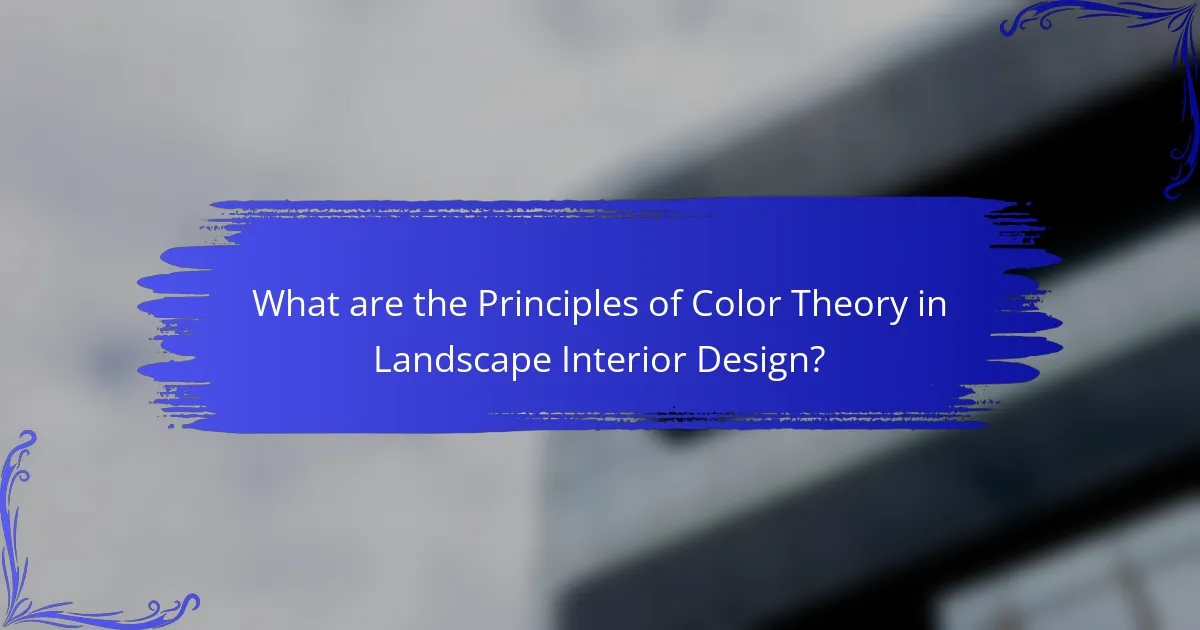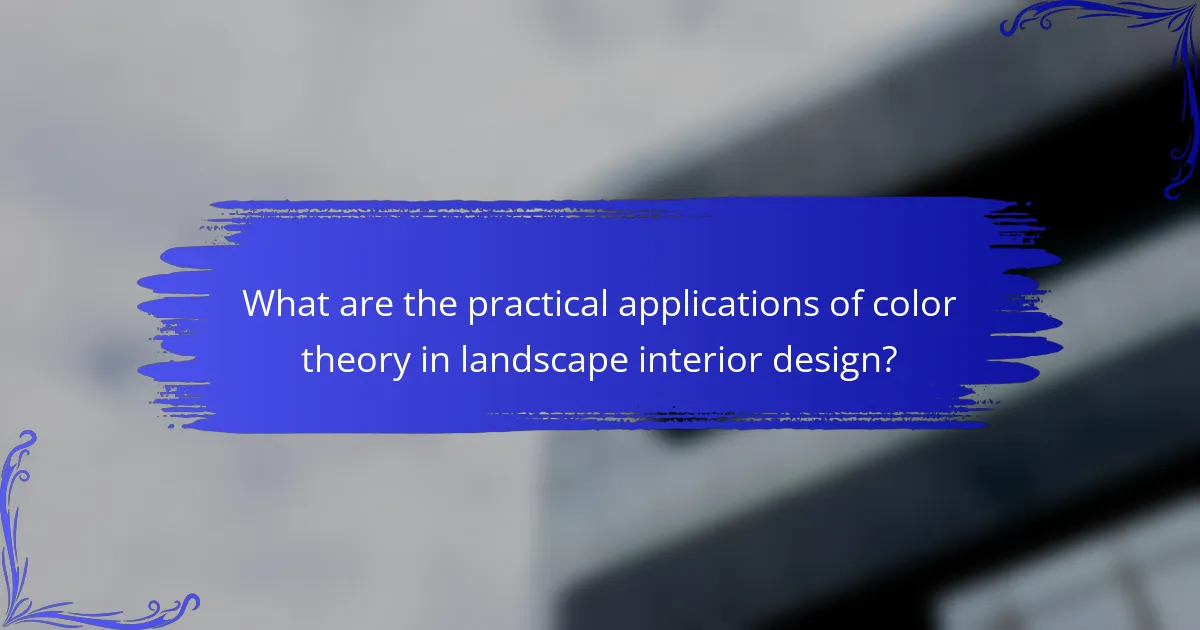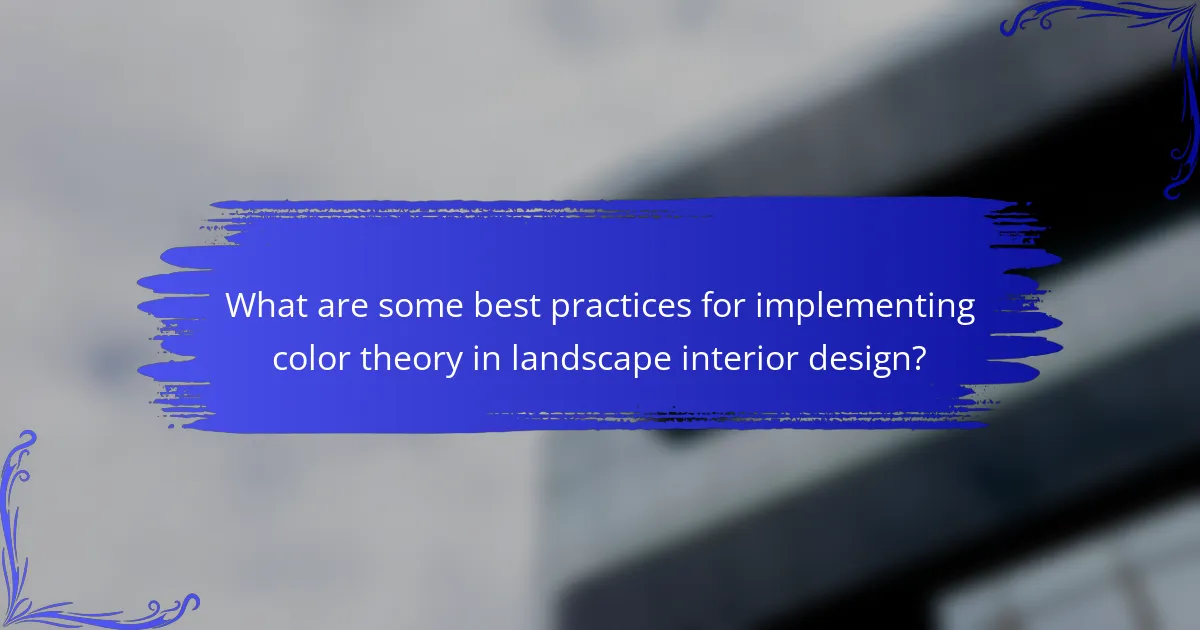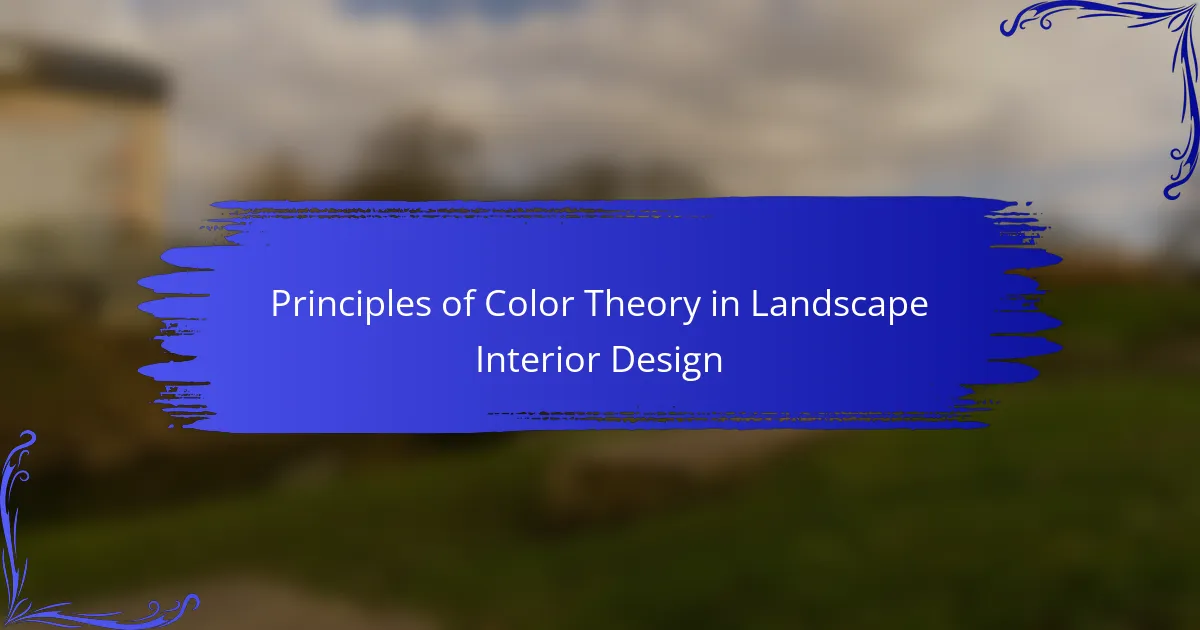Color theory is a critical aspect of landscape interior design, encompassing principles such as harmony, contrast, and balance. Harmony is achieved through complementary colors, while contrast utilizes opposing colors to create visual interest. Balance ensures an even distribution of colors, often guided by the 60-30-10 rule, which allocates dominant, secondary, and accent colors effectively. The strategic use of color can influence mood, enhance spatial perception, and guide the eye to focal points, reflecting seasonal changes and harmonizing with natural surroundings. Best practices in applying color theory include using a color wheel, considering the psychological effects of colors, and testing colors in varying lighting conditions to maintain a dynamic design.

What are the Principles of Color Theory in Landscape Interior Design?
The principles of color theory in landscape interior design include harmony, contrast, and balance. Harmony involves using colors that complement each other to create a cohesive look. This can be achieved through analogous colors, which are next to each other on the color wheel. Contrast refers to the use of opposing colors to create visual interest and highlight specific areas. For example, pairing warm colors with cool colors can create a dynamic effect. Balance ensures that colors are distributed evenly throughout the space, preventing any one area from overwhelming others. The use of the 60-30-10 rule can guide this distribution: 60% of a dominant color, 30% of a secondary color, and 10% of an accent color. These principles help create aesthetically pleasing and functional interior landscapes.
How does color influence mood and perception in landscape interior design?
Color significantly influences mood and perception in landscape interior design. Different colors evoke specific emotional responses. For instance, warm colors like red and orange can create feelings of warmth and excitement. In contrast, cool colors such as blue and green promote calmness and tranquility.
Research indicates that color can affect human psychology. A study published in the journal “Color Research and Application” shows that people associate certain colors with specific feelings. Bright colors can energize a space, while muted tones can create a more subdued atmosphere.
Moreover, color can alter the perception of space. Lighter colors can make a room feel larger, while darker shades can create intimacy. The strategic use of color can enhance the overall aesthetic and emotional impact of a landscape interior design.
What psychological effects do different colors have on space?
Different colors have significant psychological effects on space. Warm colors like red and orange can create a sense of energy and excitement. They often make spaces feel smaller and cozier. Cool colors, such as blue and green, promote calmness and relaxation. These colors can make a space appear larger and more open.
Neutral colors like beige and gray provide a balanced environment. They can enhance the feeling of spaciousness while allowing other colors to stand out. According to research by the Institute for Color Research, people make a subconscious judgment about a person, environment, or product within 90 seconds of viewing it. Color plays a crucial role in this perception.
For instance, studies show that blue can increase productivity and creativity. In contrast, yellow is often associated with happiness but can cause anxiety in large amounts. Understanding these effects helps in designing spaces that evoke desired feelings and behaviors.
How can color choices enhance the aesthetic appeal of a landscape interior?
Color choices significantly enhance the aesthetic appeal of a landscape interior. They influence mood, perception, and spatial dynamics. Warm colors like reds and oranges create an inviting atmosphere. Cool colors such as blues and greens promote tranquility and relaxation. Contrasting colors can highlight specific features or elements in a design. Harmonious color schemes lead to a cohesive and balanced look. According to color theory, colors can evoke emotional responses and affect how spaces are perceived. For example, lighter colors can make a space feel larger and more open, while darker tones can create intimacy. Thus, strategic color choices are essential in landscape interior design to achieve desired aesthetics.
What are the fundamental color concepts relevant to landscape interior design?
The fundamental color concepts relevant to landscape interior design include hue, saturation, and value. Hue refers to the actual color, such as red or blue. Saturation describes the intensity or purity of a color. High saturation means a vivid color, while low saturation indicates a more muted tone. Value pertains to the lightness or darkness of a color. Light colors have high value, while dark colors have low value.
These concepts interact to create visual harmony and contrast in a space. For instance, complementary colors enhance each other when placed together. Analogous colors, which are next to each other on the color wheel, create a serene and cohesive look. Understanding these concepts allows designers to evoke specific moods and enhance the aesthetic appeal of interior landscapes.
What is the color wheel and how is it used in design?
The color wheel is a circular diagram that represents colors and their relationships. It is used in design to create harmonious color schemes. Designers utilize the color wheel to identify complementary, analogous, and triadic color combinations. Complementary colors are opposite each other on the wheel. Analogous colors are next to each other. Triadic colors are evenly spaced around the wheel. The color wheel helps in balancing colors in a design. This tool enhances visual appeal and guides emotional responses. Its application is essential in various design fields, including landscape and interior design.
What are primary, secondary, and tertiary colors in the context of design?
Primary colors in design are red, blue, and yellow. These colors cannot be created by mixing other colors. They serve as the foundation for creating other colors. Secondary colors are formed by mixing two primary colors. For example, mixing red and blue creates purple. Tertiary colors result from mixing a primary color with a secondary color. An example is mixing blue with green to create blue-green. This color hierarchy is essential in color theory. Understanding these categories helps in effective design choices.
How do color harmonies impact landscape interior design?
Color harmonies significantly influence landscape interior design by creating visual cohesion and emotional impact. They guide the selection of colors that work well together, enhancing the aesthetic appeal of a space. For instance, analogous color schemes, which use colors next to each other on the color wheel, promote tranquility and harmony. Complementary color schemes, featuring colors opposite each other, can create vibrant contrasts that energize a space.
Research shows that color harmonies can affect mood and perception. For example, studies indicate that warm colors can evoke feelings of warmth and comfort, while cool colors can promote relaxation. The appropriate use of color harmonies can also enhance the perceived size and shape of a space, making it feel more open or intimate. In summary, color harmonies are essential in landscape interior design, influencing both aesthetics and emotional responses.
What are the different types of color harmonies?
The different types of color harmonies include complementary, analogous, triadic, split-complementary, and monochromatic. Complementary color harmony involves colors opposite each other on the color wheel, creating high contrast. Analogous harmony consists of colors next to each other, providing a serene and comfortable design. Triadic harmony uses three evenly spaced colors on the color wheel, offering vibrant and balanced compositions. Split-complementary harmony combines one base color with the two adjacent to its complementary color, enhancing visual interest. Monochromatic harmony focuses on variations in lightness and saturation of a single color, ensuring a cohesive look. These color harmonies are foundational in landscape interior design, influencing mood and aesthetic appeal.
How can contrasting colors be effectively utilized in design?
Contrasting colors can be effectively utilized in design to create visual interest and draw attention. Designers often use complementary colors, which are opposite each other on the color wheel, to enhance the vibrancy of a space. For example, pairing blue with orange or red with green can make elements stand out. This technique helps in highlighting focal points within a design. Studies show that high contrast can improve readability and comprehension in visual displays. Additionally, contrasting colors can evoke emotional responses, influencing how a space feels. The strategic use of these colors can guide viewer perception and enhance the overall aesthetic experience.

What are the practical applications of color theory in landscape interior design?
Color theory has practical applications in landscape interior design by influencing mood, spatial perception, and aesthetics. Color selection can create a sense of harmony or contrast in a space. For instance, warm colors like reds and oranges can evoke energy and warmth. Cool colors, such as blues and greens, promote calmness and relaxation.
Using color strategically can enhance the perception of space. Lighter colors can make a room feel larger, while darker shades can create intimacy. Color can also guide the eye toward focal points in a landscape design. This technique helps in highlighting specific features like plants or architectural elements.
Moreover, color combinations can reflect seasonal changes. Designers often use palettes that resonate with the natural environment. This approach creates a cohesive look that blends indoor and outdoor spaces. Studies show that color affects human emotions and behaviors, supporting the choice of colors that align with desired experiences in the space.
How can color theory guide material and plant selection?
Color theory can significantly influence material and plant selection in landscape interior design. It helps designers create harmonious and visually appealing spaces. Understanding the color wheel allows designers to choose complementary colors for materials and plants. For instance, pairing warm tones like reds and yellows with cool tones like blues and greens can enhance visual interest.
Additionally, color theory informs the emotional impact of colors. Warm colors can evoke feelings of warmth and energy, while cool colors can promote calmness and relaxation. This emotional response can guide the selection of plants and materials to suit the desired atmosphere of the space.
Research by the American Society of Landscape Architects indicates that color can affect perceptions of space and mood. In practical terms, using bright colors for focal plants can draw attention, while neutral materials can provide balance. Thus, color theory serves as a foundational tool for making informed design choices.
What are the best color combinations for various landscapes?
The best color combinations for various landscapes include complementary, analogous, and triadic schemes. Complementary combinations, such as blue and orange, create vibrant contrasts. Analogous colors like green, blue, and teal provide harmonious blends. Triadic schemes, such as red, yellow, and blue, offer balanced diversity. These combinations enhance visual appeal and evoke specific emotions. Research shows that color schemes significantly impact perception and mood in landscapes. For instance, warm colors can create a sense of energy, while cool colors promote calmness.
How does seasonal change affect color choices in landscape design?
Seasonal change significantly influences color choices in landscape design. Different seasons offer distinct palettes that resonate with nature. For instance, spring often features vibrant colors like pinks and yellows from blooming flowers. Summer typically embraces lush greens and bright hues, reflecting the full foliage. Autumn introduces warm tones such as oranges, reds, and browns as leaves change. Winter often favors muted colors and evergreens, creating a tranquil atmosphere.
Designers consider these seasonal shifts to create harmonious landscapes. Research indicates that color perception can evoke emotions and affect mood. For example, warm colors can create feelings of warmth and comfort in colder months. Seasonal color choices enhance the visual appeal of landscapes throughout the year.
What role does lighting play in the perception of color in landscape interiors?
Lighting significantly influences the perception of color in landscape interiors. Different types of lighting, such as natural and artificial, can alter how colors appear. Natural light varies throughout the day, affecting color temperature and saturation. Artificial lighting, including LED and incandescent, can cast different hues, changing color perception. For instance, warm lighting enhances reds and yellows, while cool lighting emphasizes blues and greens. The direction of light also impacts shadows and highlights, further modifying color appearance. Studies show that the right lighting can enhance the aesthetic appeal of interior landscapes, making colors appear more vibrant and cohesive.
How does natural light influence color appearance?
Natural light significantly influences color appearance by altering how colors are perceived. The spectrum of natural light varies throughout the day, affecting color temperature and intensity. Morning light tends to be cooler and bluer, while afternoon light is warmer and yellower. This variation can make the same color appear differently at different times. For instance, a room painted in a soft blue may look serene in morning light but warmer and more inviting in the afternoon. Studies show that natural light can enhance the vibrancy of colors, making them appear more saturated. Additionally, the direction of light can create shadows, further changing the perception of color. Overall, the quality and angle of natural light play crucial roles in color theory within interior design.
What are the effects of artificial lighting on color perception in landscape design?
Artificial lighting significantly affects color perception in landscape design. Different light sources can alter how colors are viewed. For instance, warm light can enhance reds and yellows, while cool light can make blues and greens appear more vibrant. The color temperature of artificial lighting influences mood and ambiance. High-intensity lighting can wash out colors, diminishing their visual impact. Conversely, strategically placed lighting can highlight specific features, enhancing their appeal. Studies show that color perception varies under different lighting conditions, confirming the importance of selecting appropriate artificial lighting in landscape design.

What are some best practices for implementing color theory in landscape interior design?
Best practices for implementing color theory in landscape interior design include using a color wheel for guidance. The color wheel helps identify complementary and analogous colors. Choose a dominant color for the main elements to create a cohesive look. Use accent colors to highlight specific features or areas. Consider the psychological effects of colors; for example, blue promotes calmness while yellow adds energy. Ensure colors harmonize with the natural surroundings to enhance the overall aesthetic. Test colors in different lighting conditions to see how they change throughout the day. Incorporate seasonal variations in color to keep the design dynamic and engaging.
How can designers effectively create a cohesive color palette?
Designers can effectively create a cohesive color palette by utilizing color theory principles. They should start by selecting a base color that reflects the desired mood or theme. Next, they can use the color wheel to choose complementary, analogous, or triadic colors that harmonize well with the base color. Consistency in saturation and brightness across selected colors enhances cohesion. Additionally, designers should consider the context and lighting of the space, as these factors influence color perception. A well-planned color palette can evoke specific emotions and create a balanced visual experience. Studies show that color harmony can significantly affect user experience and perception in design.
What steps should be taken to test color combinations before implementation?
Identify the color combinations to be tested. Create a palette using the selected colors. Apply the colors to a digital mockup or physical sample. Assess the combinations under different lighting conditions. Gather feedback from stakeholders or target audience. Make adjustments based on feedback and observations. Finalize the color combinations for implementation. Document the testing process for future reference.
How can designers ensure that their color choices align with the intended design theme?
Designers can ensure that their color choices align with the intended design theme by establishing a clear color palette. This palette should reflect the emotions and messages of the theme. Designers can utilize color theory principles, such as complementary and analogous color schemes. They should also consider cultural associations with colors relevant to the theme. Testing colors in different lighting conditions can reveal how they interact with the environment. Additionally, gathering feedback from stakeholders can help refine color selections. Research indicates that color impacts perception and mood, reinforcing the importance of thoughtful color choices in design.
What common mistakes should be avoided when applying color theory in landscape interior design?
Common mistakes to avoid when applying color theory in landscape interior design include using too many colors. A limited color palette creates harmony and focus. Ignoring the surrounding environment is another mistake. Colors should complement natural elements outside. Failing to consider lighting can lead to unexpected results. Natural light affects how colors appear throughout the day. Not testing colors in the actual space is also common. Colors can look different in various settings. Overlooking the emotional impact of colors is important. Each color can evoke specific feelings and moods. Lastly, neglecting the balance between warm and cool tones can disrupt visual appeal. A balanced approach enhances the overall design.
How can overuse of color impact the overall design?
Overuse of color can negatively impact overall design by creating visual chaos. It can overwhelm viewers and distract from key elements. Excessive colors may lead to confusion regarding the design’s focal points. A study by the Institute of Color Research found that people make a subconscious judgment about a person, environment, or product within 90 seconds, primarily based on color. This indicates that inappropriate color use can diminish aesthetic appeal. Additionally, overuse can evoke unintended emotional responses, detracting from the intended atmosphere. Effective design relies on balance and harmony, which excessive color disrupts.
What are the pitfalls of ignoring the surrounding environment when choosing colors?
Ignoring the surrounding environment when choosing colors can lead to mismatched aesthetics and reduced harmony. Colors that clash with the surroundings may create visual discomfort. This can detract from the overall design intent and make spaces feel uninviting. Additionally, environmental colors can influence perception and mood. For example, warm colors may feel out of place in a cool, natural setting. Research shows that color perception is affected by context, highlighting the importance of cohesive color choices. Inconsistent color schemes can also decrease property value and appeal. Ultimately, neglecting the environment risks undermining the effectiveness of design.
What are some practical tips for selecting colors in landscape interior design?
Select colors that complement the landscape and interior elements. Consider the natural surroundings and existing architecture. Use a color wheel to identify harmonious color combinations. Neutral colors can create a calming effect and highlight other elements. Incorporate seasonal colors for a dynamic look throughout the year. Test color samples in different lighting conditions for accurate perception. Consider the psychological effects of colors on mood and space perception. Research shows that color can influence emotions, impacting overall design effectiveness.
How can a designer balance personal taste with functional needs in color selection?
A designer can balance personal taste with functional needs in color selection by prioritizing the purpose of the space. Understanding the emotional impact of colors is essential. For example, blue can create a calming effect, while yellow may energize a room. The designer should also consider the lighting conditions in the environment. Natural light can alter color perception significantly. Additionally, gathering client input ensures personal preferences are included. Combining this feedback with knowledge of color psychology leads to effective choices. Studies show that color can influence mood and behavior, reinforcing the importance of thoughtful selection. Ultimately, a harmonious blend of aesthetics and functionality creates a successful design.
What resources are available for designers to explore color theory further?
Designers can explore color theory through various resources. Books such as “Interaction of Color” by Josef Albers provide foundational knowledge. Online courses on platforms like Coursera and Skillshare offer structured learning. Websites like Adobe Color and Coolors help in practical color palette creation. Color theory blogs and forums facilitate community discussions and insights. Additionally, academic journals publish research on color perception and application. These resources collectively enhance understanding of color theory in design contexts.
The main entity of this article is the principles of color theory in landscape interior design. The article explores key concepts such as harmony, contrast, and balance in color application, highlighting their impact on mood, perception, and spatial dynamics. It discusses the psychological effects of different colors, the role of the color wheel, and various color harmonies, along with practical applications for material and plant selection. Additionally, the article addresses best practices for creating cohesive color palettes and common mistakes to avoid when implementing color theory in design.
